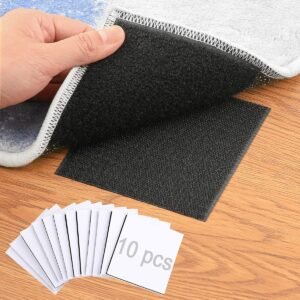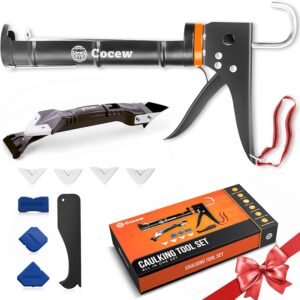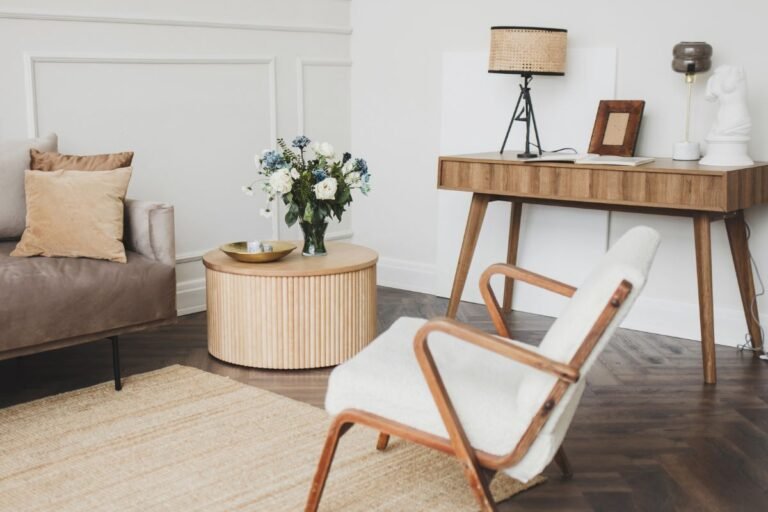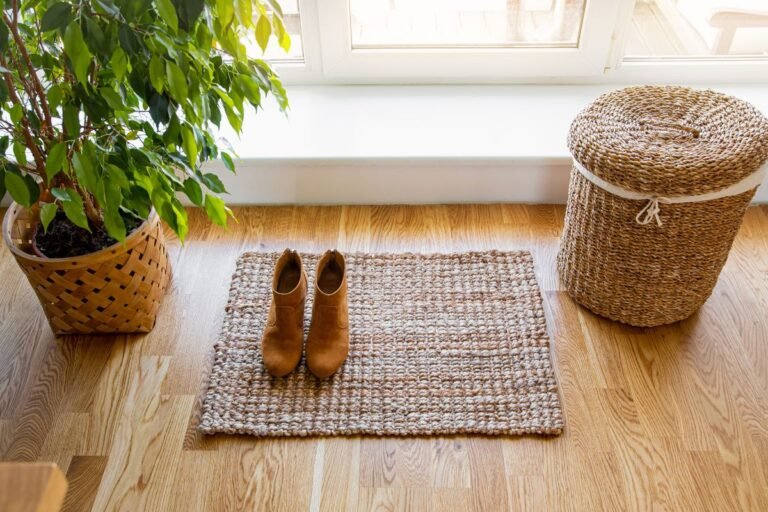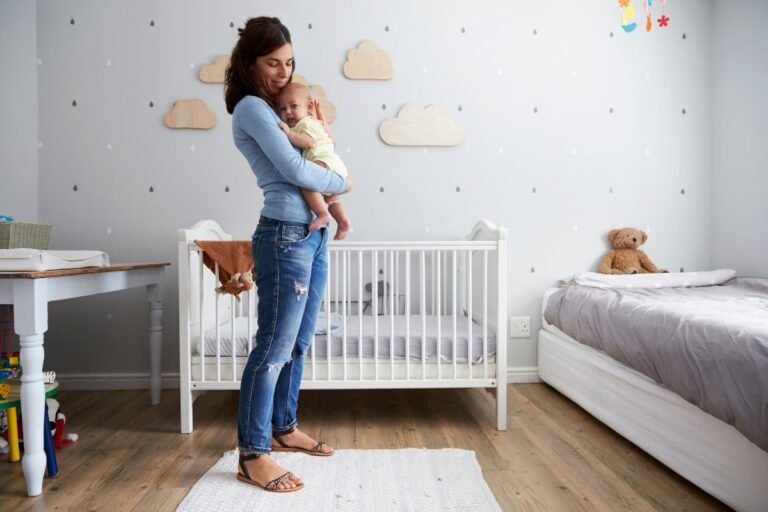Key Takeaways for keeping rugs from slipping
- I’d go with a rug pad over any other type of rug gripper. They’re better quality, longer lasting, and will get the job done the first time.
- Vacuum and clean regularly, it seriously helps.
- If the corners of your area rug are coming up or shifting around, then rug anchors, or rug grippers, are an affordable way to keep rug corners in place.
- Some people like to use hot glue to keep rugs from sliding but that seems extremely temporary to me.
Rugs are the perfect accent to any room, but they can be a pain if they won’t stay in place! If you’ve ever tried to keep your rugs from sliding around on your hardwood, laminate, or tile floors, you know how annoying it can be.
Fortunately, there are plenty of ways to keep your rugs in place without damaging your floors.
I’ll review all of the ways to keep rugs from sliding, but I’m just gonna warn you now: I’m biased. I always think rug pads are the best option.
How to stop rugs from sliding
Keeping rugs in place seems like a lifelong battle that I have triumphantly conquered. Here is what I learned along the way.
Non Slip Rug Pads
Recommended: 10/10
One of the easiest and most effective ways to keep rugs in place is to use a rug pad. Rug pads come in different materials and thicknesses, and can be found at most home goods stores.
It provides a strong non slip grip on the floor, preventing rugs from sliding and shifting. Natural rubber is also environmentally friendly and safe for all flooring types, including laminate, hardwood, and tile.
Smaller rugs, like a kitchen rug, or rugs in areas in high traffic areas, like a runner rug, do best with low profile natural rubber pads with a grid like pattern. This will lock small rugs in place without damaging the floors. It will also keep your rug nice and flush with the floor, rather than all bunched and curled.
Large area rugs, like those in the dining room or living room, could go for a little bit more padding. In this case, adding a thick layer of recycled felt to the rubber pads is a better option.
100% recycled felt pads with natural rubber backing is another great option for a non-slip rug pad. The felt provides a soft, cushioning layer that protects the floor, while the natural rubber backing provides a strong grip to prevent sliding. This combination of materials is safe for all flooring types, including laminate, hardwood, and tile.
It’s important to note that only EVA (Ethylene Vinyl Acetate) backing is safe for any type of vinyl floor surface. While natural rubber and recycled felt with natural rubber backing are safe for other flooring types, they may cause damage to vinyl flooring.
If you have vinyl flooring, it’s best to use a rug pad with an EVA backing to ensure the safety of your floor.
Still not sure which one is for you? I made this cool quiz that matches up the rug pads that are safe for your floor type and provide the feeling you’re looking for. Give it a try 🙂
Not sure which rug pad to get?
Take the quiz to get started!
We recommend:
Rug pads also help protect floor from furniture, making them doubly useful.
Double-Sided Carpet Tape
Recommended: 6/10
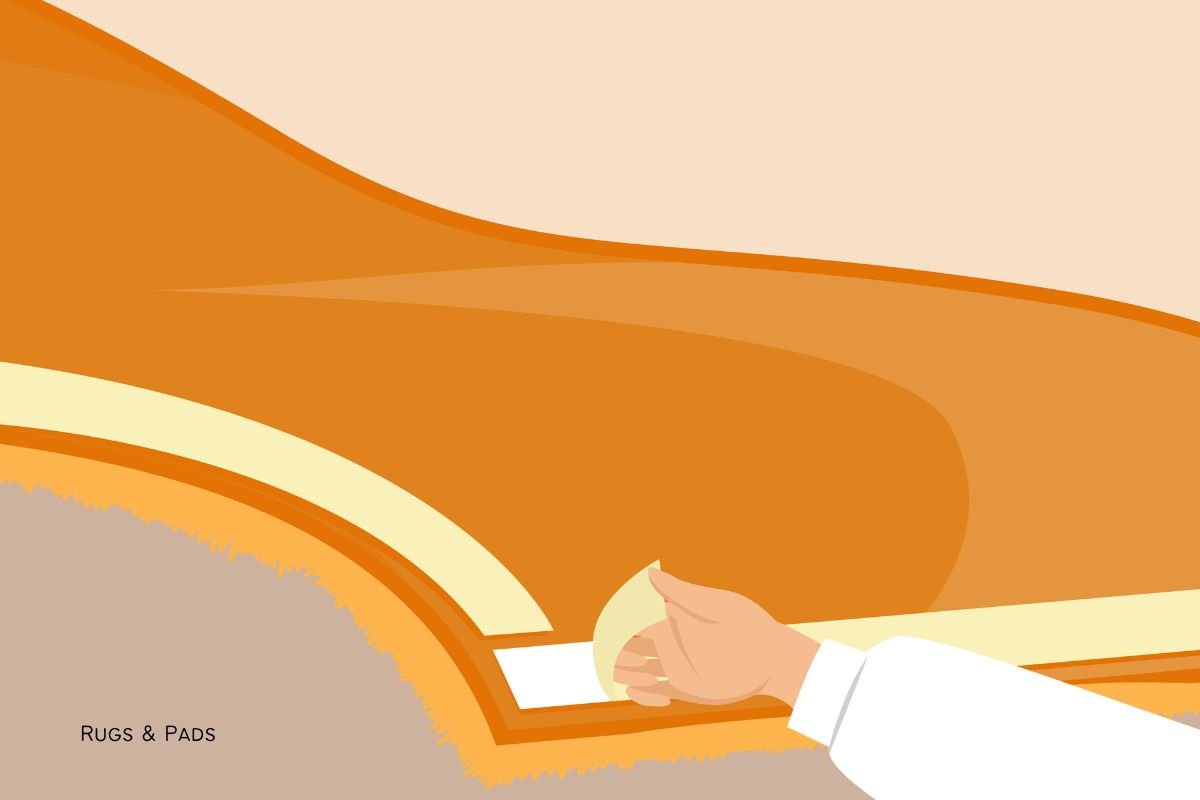
Double-sided carpet tape, or rug tape, is a budget-friendly option that can be used to secure rugs to the floor. To make your rug non-slip, simply peel off the backing and stick the double sided tape to the back of the rug, then press the rug firmly onto the floor.
As easy as it is to plop some carpet tape down to keep rugs from sliding, it can also come with a few risks. Carpet tape can leave a sticky residue on the floor when it’s removed, which can be difficult to remove and may cause damage to the floor.
While carpet tape is generally meant for carpets, rug tape is meant for other floor finishes. Depending on the type of flooring, the adhesive from the rug tape can penetrate the surface and cause damage, especially if the tape is left in place for an extended period of time. Hardwood floors and laminate floors are particularly vulnerable to damage from carpet tape.
If you do get away with using carpet tape on your floor’s surface, there’s still the likelihood that, over time, the adhesive on the carpet tape can lose its stickiness, reducing its ability to hold the rug in place. This can result in the rug slipping and sliding, defeating the purpose of using the tape.
To avoid damage, it’s important to use a type of carpet tape that is designed for use on the specific type of flooring you have. For example, there are types of carpet tape that are formulated specifically for use on hardwood floors, while others are designed for use on tile or carpet.
To be safe, it’s a good idea to periodically check the tape to ensure it’s still securely holding the rug in place. If the tape is no longer holding, it’s best to remove it and find a different solution to prevent the rug from slipping and sliding.
If you’re unsure about which type of carpet tape is safe for your flooring, it’s best to consult a flooring specialist or the manufacturer of the flooring before using the tape.
Rugs With Rubber Backing
Recommended: 5/10
Some rugs come with rubber backing, which provides additional grip and helps to keep the rug in place.
If you’re looking for an area rug with rubber backing, then look for one that is safe for all floor types. This is usually made with natural rubber.
Most non-slip area rugs are made with synthetic materials, which can damage hardwood floors and vinyl floors. The toxic chemicals can also be irritating to people with asthma or other sensitivities.
Otherwise, Mohawk has a bunch of area rugs with rubber backing to keep rugs from sliding. Like this one, it’s made with a latex backing to keep the rug in place.
Just keep in mind that latex is not safe for all floor finishes.
This is why I love going for RugPadUSA’s rug pad options… they’re all safe for more floor surface types and come with varying thickness levels. Plus, you also get to change your area rug whenever you feel like a vibe change.
Furniture Placement
Recommended: 8/10
Placing furniture, such as sofas or chairs, on top of the rug can help to keep it in place and prevent sliding.
Using furniture to anchor a rug in place can be a great solution in certain situations. Here are some examples:
- Rug Sizes: If you have a smaller rug, such as a 2×3 or 4×6 foot rug, using furniture to anchor it can be an effective solution. Placing the corners of the rug under heavy furniture, such as a sofa, chairs, or a coffee table, can help keep it in place.
- Furniture Type: Furniture with heavy legs, such as sofas, loveseats, and armchairs, are ideal for anchoring rugs. Furniture with smaller legs, such as side tables, may not provide enough weight to anchor a rug effectively.
- Room Type: Using furniture to anchor a rug is a good idea in rooms with low foot traffic, such as a living room or bedroom. In high-traffic areas, such as hallways or entryways, it’s better to use a rug pad or non-slip solution, as the constant movement can cause the rug to shift and become dislodged from the furniture.
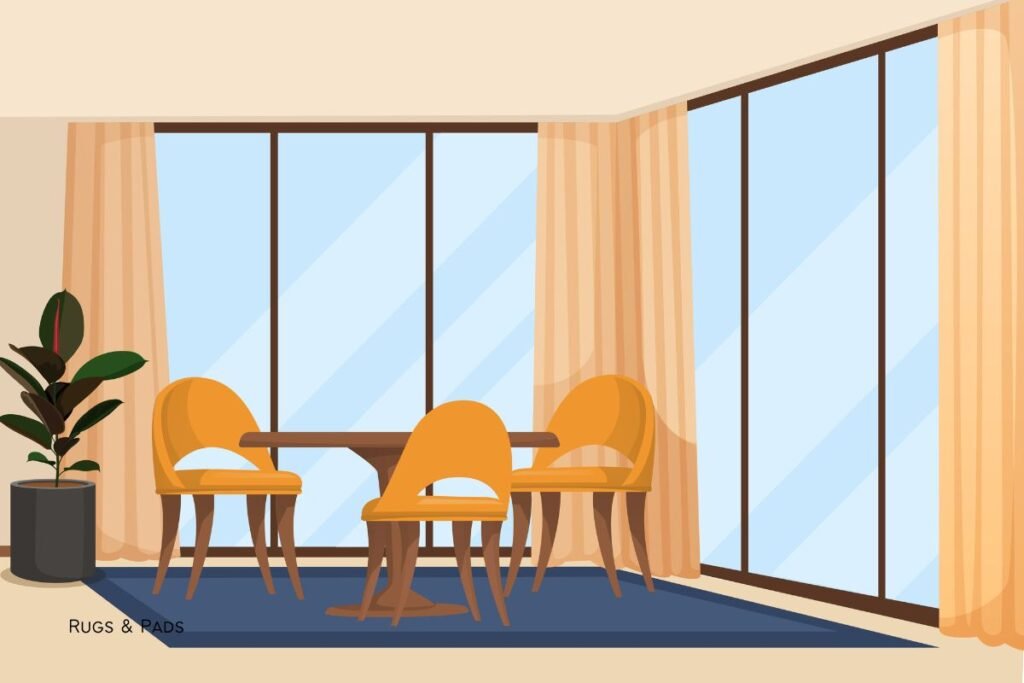
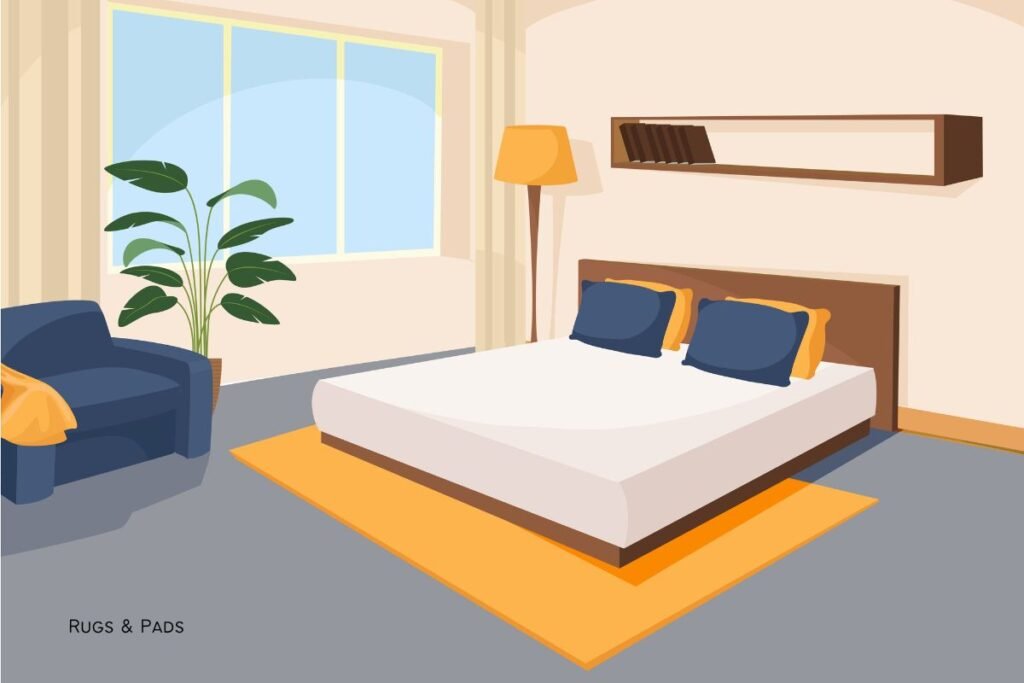
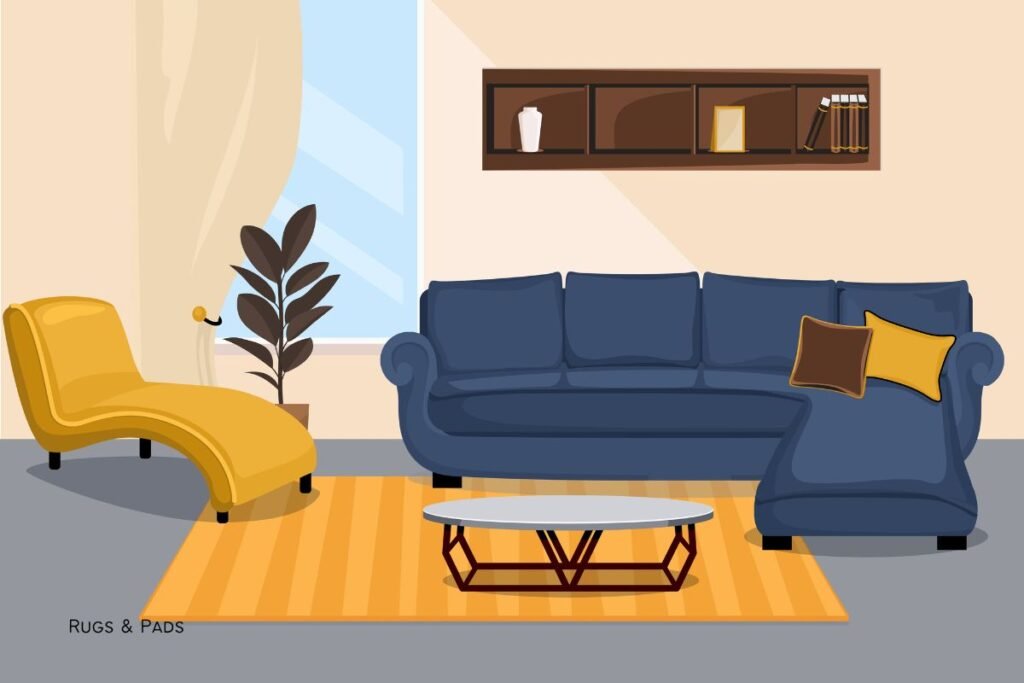
It’s important to note that using furniture to anchor a rug should only be done with rugs that are small enough to be effectively secured. Larger rugs, or rugs in high-traffic areas, may require a more secure solution, such as a rug pad or non-slip spray.
If you have hardwood or other delicate flooring, using furniture to anchor a rug may cause scratches or other damage. In these cases, it’s best to use a rug pad to protect both your rug and your flooring.
STYLE YOUR ROOM: Read my Bedroom Rug Placement Guide for more ideas about how to put furniture on top of your area rugs!
Hook and Loop Strips
Recommended: 3/10
Hook and loop (most notable brand “Velcro”) strips can be attached to the back of a rug and to the floor to prevent sliding. This is a good option for those who want a less permanent solution.
Hook and loop strips are a type of fastener consisting of two pieces, one with tiny hooks and the other with tiny loops. They are used to securely attach two surfaces together and are often used as a temporary or reusable solution.
To use Velcro strips to keep an area rug in place, you can attach one strip to the back of the rug and another strip to the floor. The hooks on the rug strip will attach to the loops on the floor strip, keeping the rug securely in place.
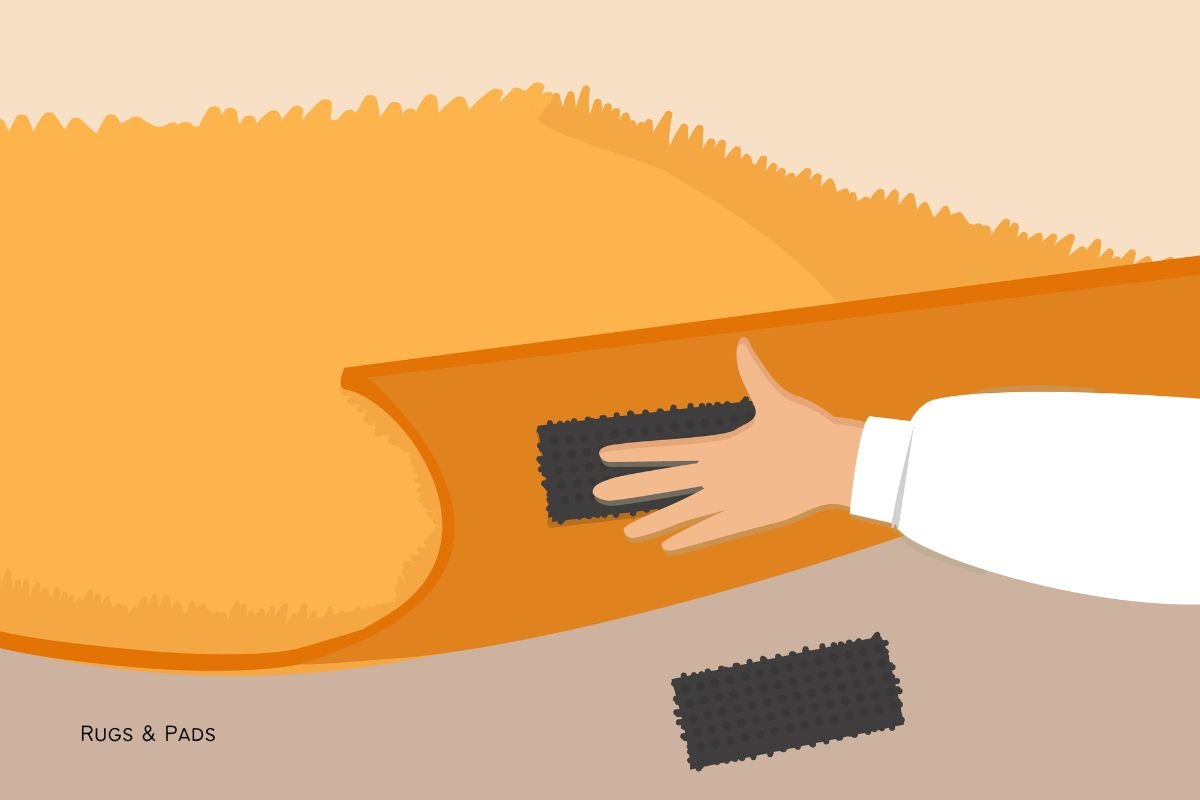
To determine how much hook and loop strip you need, measure the perimeter of your rug and add a few extra inches to spare. You can purchase hook and loop strips in rolls or pre-cut lengths, depending on your needs.
You could also go with the pre-shaped patches for an effective grip.
The lifespan of hook and loop strips depends on several factors, including frequency of use, exposure to sunlight, and temperature fluctuations. In general, hook and loop strips can last for several years if properly maintained and stored. However, over time, the hooks and loops can become worn, making the strips less effective at holding two surfaces together. In this case, the strips can be easily replaced.
Please note, it is important to check the flooring manufacturer’s instructions before using any adhesive products, as some adhesives may damage certain types of flooring.
Silicone caulking
Recommended: 8/10 for outdoors
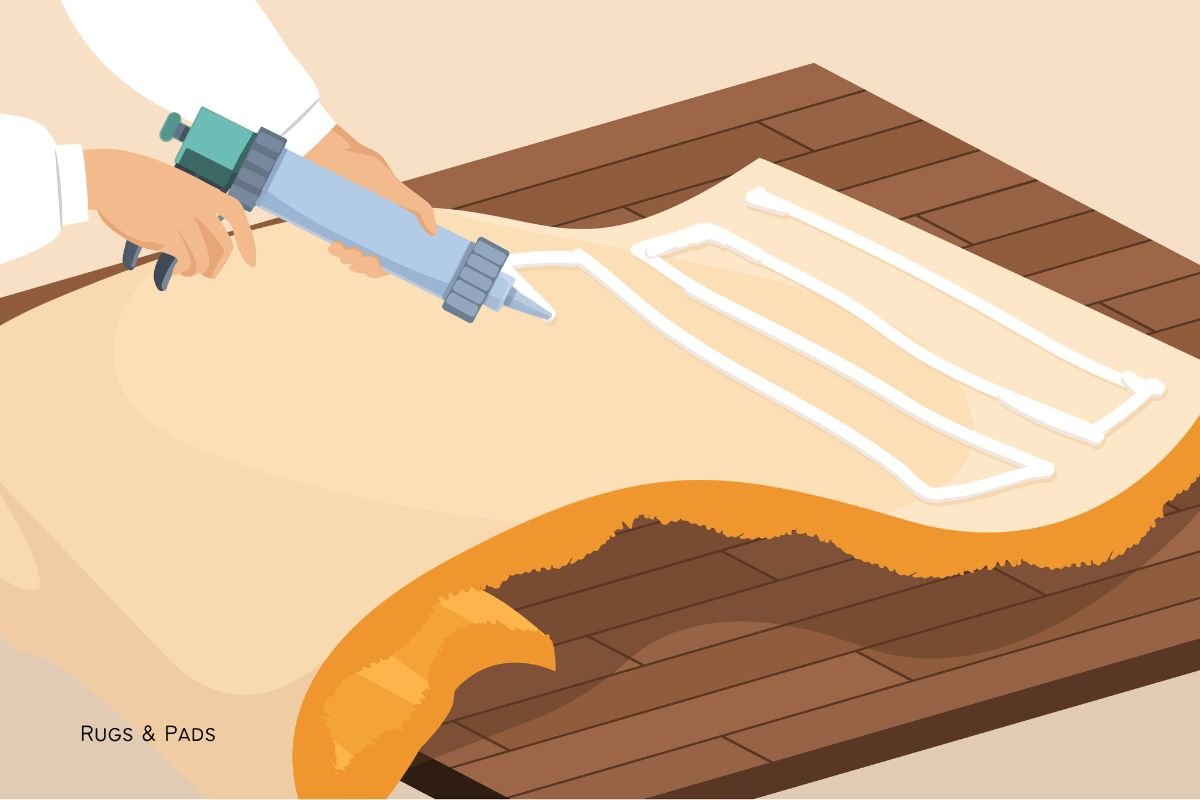
Using silicone caulking to keep rugs in place is a simple and inexpensive solution. While it will certainly help with keeping rugs in place, it’s best used for outdoor surfaces.
Here are the steps to follow:
- Clean the floor: Clean the floor where the rug will be placed to remove any dirt, dust, or debris. This will ensure that the silicone caulk will adhere properly.
- Apply the silicone caulking: Squeeze a continuous bead of silicone caulking along the perimeter of the rug, where it will come into contact with the floor. Spread the silicone evenly with a caulking tool to create a thin and even layer.
- Press the rug into place: Carefully place the rug on top of the silicone caulking, making sure that it is centered and that the silicone is evenly distributed. Use a roller or a heavy object to press the rug into the silicone, ensuring that it is firmly in place.
- Allow the silicone to dry: Allow the silicone to dry completely, following the manufacturer’s recommended drying time. This typically takes 24 to 48 hours.
Here’s a helpful video of exactly how to apply it:
Note: Silicone caulk is safe for use on most flooring surfaces, including hardwood, laminate, tile, and concrete. However, it may not be suitable for use on some surfaces, such as vinyl flooring, which can be sensitive to adhesives. Always test a small, inconspicuous area of your flooring before using silicone caulking to make sure that it does not cause any damage.
Gaffers Tape
Recommended: 1/10
For rental properties, gaffers tape is a good temporary solution for securing rugs. It is a strong, non-damaging tape that can be easily removed when needed.
Gaffer’s tape, also known as gaffer tape or cloth tape, is a heavy-duty, matte-finish, pressure-sensitive tape that is used for a variety of purposes in various industries, such as film, television, theater, and live events.
People use gaffer’s tape for a variety of tasks, including:
- Cable Management: Gaffer’s tape is often used to secure and organize cables and wires, as it can be easily torn by hand and removed without leaving residue.
- Floor Marking: In theater and live events, gaffer’s tape is used to mark stage flooring and create pathways for performers. The matte finish and low-reflective properties of gaffer’s tape make it ideal for these applications.
- Temporary Repairs: Gaffer’s tape is often used for temporary repairs, such as fixing ripped clothing, mending broken props, or securing loose set pieces.
- Mounting and Hanging: Gaffer’s tape is also used for mounting and hanging posters, banners, and decorations, as it can securely hold items in place but can also be removed easily without damaging surfaces.
Overall, gaffer’s tape is a versatile and indispensable tool in a variety of industries due to its strong adhesion and residue-free removal capabilities.
HOWEVER, I’d recommend going with a rug pad or something more flexible and less permanent. As amazing as this tape is, the potential to ruin floors is too high for my liking.
More About Rug Pads
- The 5 Best Rug Pads for Hardwood Floors
- How To Secure Area Rug On Top Of Carpet (The Safe Way)
- Best Non-Toxic Rug Pads Safe For Children And Pets
- How To Size A Rug Pad, Expert Tips
- The Best Memory Foam Rug Pad for Maximum Comfort
- Best soundproofing rug pads: 3 options for a quiet barrier
- This Is The Best Rug Pad For Vinyl Plank Flooring
- Rug Pad Thickness Guide: How To Choose Rug Pad Thickness










